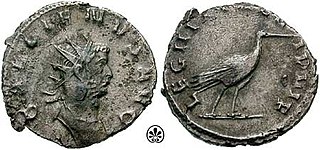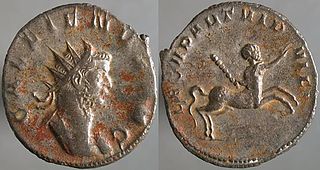This article needs additional citations for verification .(January 2021) |

Legio II Italica ("Italian Second Legion") was a legion of the Imperial Roman army.
This article needs additional citations for verification .(January 2021) |

Legio II Italica ("Italian Second Legion") was a legion of the Imperial Roman army.
Originally having the cognomen Pia, the legion was raised alongside III Italica by emperor Marcus Aurelius when legions sent from the Danube frontier to the East to take part in the Parthian War could not be quickly recalled. There is good evidence to show both legions were raised in AD 165. [1]
The legion's main theatre of operations was the Roman province of Noricum, in the southern margin of the Danube, where Germanic incursions were frequent.
In 180 II Italica was stationed in Lauriacum, modern Lorch.
In 193, II Italica marched into Rome with Septimius Severus, then fighting for power. The new emperor awarded them the title of Fidelis (loyal) to acknowledge their support. Later Septimius Severus would use II Italica against the rebellions of Pescennius Niger and Clodius Albinus, as well as in his Parthian campaigns.
In the 3rd century, support of the legions was of crucial importance to candidates for the throne. Well aware of this fact, Gallienus granted II Italica the cognomina VII Pia VII Fidelis (seven times faithful, seven times loyal) to secure their continuing support.[ citation needed ]
There are still records of the II Italica in Noricum in the beginning of the 5th century.[ citation needed ]
The legion symbol is a she-wolf and the twins Romulus and Remus, a reference to the rule of Marcus Aurelius and his colleague Lucius Verus.[ citation needed ]

Legio XIV Gemina was a legion of the Imperial Roman army, levied by Julius Caesar in 57 BC. The cognomen Gemina (Twinned) was added when the legion was combined with another understrength legion after the Battle of Actium. The cognomen Martia Victrix was added following their service in the Pannonian War c. AD 9 and the defeat of Boudicca in AD 61. The emblem of the legion was the Capricorn, as with many of the legions levied by Caesar.

Legio I Italica was a legion of the Imperial Roman army founded by emperor Nero on September 22, 66. The epithet Italica is a reference to the Italian origin of its first recruits. It was stationed at Novae, near modern-day Svishtov (Bulgaria). There are still records of the I Italica on the Danube border at the beginning of the 5th century. The emblem of the legion was a boar.

Legio I Minervia was a legion of the Imperial Roman army founded in AD 82 by emperor Domitian (r. 81–96), for his campaign against the Germanic tribe of the Chatti. Its cognomen refers to the goddess Minerva, the legion's protector. There are still records of the I Minervia in the Rhine border region in the middle of the 4th century. The legion's emblem is an image of goddess Minerva.

Legio I Adiutrix, was a legion of the Imperial Roman army founded in AD 68, possibly by Galba when he rebelled against emperor Nero. The last record mentioning the Adiutrix is in 344, when it was stationed at Brigetio, in the Roman province of Pannonia. The emblem of the legion was a capricorn, used along with the winged horse Pegasus, on the helmets the symbol used by I Adiutrix legionaries was a dolphin.
Legio XXX Ulpia Victrix was a legion of the Imperial Roman army. Their emblems were the gods Neptune and Jupiter and the Capricorn. Ulpia is Trajan's own gens (Ulpia), while the cognomen "Victrix" means "victorious", and was awarded after their valiant behaviour in the Dacian wars. The legion was active until disbandment of the Rhine frontier in the beginning of the 5th century.

Legio II Traiana, was a legion of the Imperial Roman army raised by emperor Trajan, along with XXX Ulpia Victrix, for the campaigns in Dacia. Records of the II Traiana Fortis have been recovered from Egypt dating to the middle of the 5th century. The legion's emblem was the demi-god Hercules.

Legio II Adiutrix, was a legion of the Imperial Roman army founded in AD 70 by the emperor Vespasian, originally composed of Roman navy marines of the classis Ravennatis. There are still records of II Adiutrix in the Rhine border in the beginning of the 4th century. The legion's symbols were a Capricorn and Pegasus.

Legio X Gemina, was a legion of the Imperial Roman army. It was one of the four legions used by Julius Caesar in 58 BC, for his invasion of Gaul. There are still records of the X Gemina in Vienna in the beginning of the 5th century. The legion symbol was a bull. Early on in its history, the legion was called X Equestris (mounted), because Caesar once used the legionaries as cavalry.

Legio III Gallica was a legion of the Imperial Roman army. The cognomen Gallica suggests that its earliest recruits came from veterans of the Gallic legions of Gaius Julius Caesar, a supposition supported by its emblem, a bull, a symbol associated with Caesar. The legion was based for most of its existence at Raphanea, Roman Syria, and was still active in Egypt in the early 4th century.

Legio III Italica was a legion of the Imperial Roman army founded in AD 165 by the emperor Marcus Aurelius for his campaign against the Marcomanni tribe. The cognomen Italica suggests that the legion's original recruits were mainly drawn from Italy. The legion was still active in Raetia and other provinces in the early 5th century.

Legio IV Scythica, also written as Legio IIII Scythica, was a legion of the Imperial Roman army founded c. 42 BC by the general Mark Antony, for his campaign against the Parthian Empire, hence its other cognomen, Parthica. The legion was still active in Syria in the early 5th century.

Legio II Parthica was a legion of the Imperial Roman army founded in AD 197 by the emperor Septimius Severus, for his campaign against the Parthian Empire, hence the cognomenParthica. The legion was still active in the beginning of the 5th century. The legion's symbol was a centaur.

Legio VI Victrix was a legion of the Imperial Roman army founded in 41 BC by the general Octavian. It was the twin legion of VI Ferrata and perhaps held veterans of that legion, and some soldiers kept to the traditions of the Caesarian legion.

Legio V Macedonica was a Roman legion. It was probably originally levied in 43 BC by consul Gaius Vibius Pansa Caetronianus and Gaius Iulius Caesar Octavianus. It was based in the Balkan provinces of Macedonia, Moesia and Dacia. In the Notitia Dignitatum records from beginning of the fifth century, the legion was still stationed in Dacia, with detachments stationed in the east and Egypt.

Legio IV Flavia Felix, was a legion of the Imperial Roman army founded in AD 70 by the emperor Vespasian from the cadre of the disbanded Legio IV Macedonica. The legion was active in Moesia Superior in the first half of the 5th century. The legion symbol was a lion.

Legio VII Claudia was a legion of the Imperial Roman army.

Legio XI Claudia was a legion of the Imperial Roman army. The legion was levied by Julius Caesar for his campaign against the Nervii. XI Claudia dates back to the two legions recruited by Julius Caesar to invade Gallia in 58 BC, and it existed at least until the early 5th century, guarding lower Danube in Durostorum.

Legio XV Apollinaris was a legion of the Imperial Roman army. It was recruited by Octavian in 41/40 BC. The emblem of this legion was probably a picture of Apollo, or of one of his holy animals.
Pia Fidelis, Latin feminine form for "pious and faithful", was the cognomen of several Roman legions, awarded by an emperor when the legion had proved "devoted and loyal". Some legions received this honour several times, and their name included the number of awards.